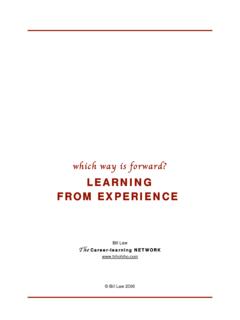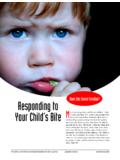Transcription of Blended Learning—Current Use, Challenges and …
1 Blended learning Current Use, Challenges and best Practices Report 2013 Contents Background and Methodology .. 3 Executive Summary .. 3 Survey Results in detail .. 5 How is Blended learning used? .. 5 How does Blended learning vary with different learner populations? .. 8 Trends in the use of Blended learning .. 9 Blended learning expertise .. 11 Blended learning in the future key Challenges .. 12 best practice and learning .. 13 Blended learning 10 Tips .. 18 Blended learning Current Use, Challenges and best Practice, Report 2013 Page 2 Background and Methodology The Oxford Group and Kineo both have a passion for learning and development and for providing solutions that result in measurable improvements in business performance.
2 As organisations become more complex and more global, we ve seen our clients trying to navigate their way quickly through the increasing variety of learning methods available. They want to create learning blends which reach their target audience effectively, rapidly and economically but aren t always sure where to start. As learning providers, we always aim to share our insights with our clients, and as The Oxford Group and Kineo work together on Blended solutions, early in 2013 we decided to carry out a research project. We wanted to explore the current use of Blended learning , best practice and the Challenges facing those adopting a Blended approach to learning & development.
3 As part of this research we surveyed a wide range of companies, asking a structured set of questions to build up a picture of how they use Blended learning and the trends they are seeing, as well as to gather examples of best practice and learning . Over 100 organisations replied, from relatively small organisations to those with more than 50,000 employees. Irrespective of the size of the company, the majority (51%) of our respondents operate internationally or globally. They represent a wide range of industries: not surprisingly given the content of the survey, 31% work in learning & development and the wider education sector; however other major contributors were government, financial services, healthcare & pharmaceuticals, manufacturing, telecoms & IT.
4 Companies represented include those as diverse as Deloitte, Siemens, Standard Bank, Telef nica and WaterAid. We would like to thank all of those who participated in the survey and provided such interesting insights. This report highlights the key conclusions from this survey. Executive Summary Our research appears to show that L&D people have accepted that the learning landscape needs to encompass a wide range of learning methods, and are having varying degrees of success in using Blended learning to its full potential. The survey identified five key conclusions: 1. Blended learning is well-established but not necessarily well Blended : Blended learning solutions are an important part of the learning & development landscape, with 86% of our respondents combining technological and traditional learning methods frequently or sometimes.
5 Combining more than one learning method into a solution is no longer unusual. Our respondents did, however, highlight the dangers of having a team of designers working in their silos on each different learning element, rather than there being a single vision for the blend to which each learning method contributes. 2. In designing a blend we take into account both learning objectives and organisation drivers: Whilst the most common factor used in selecting learning methods to include in a blend is appropriateness in meeting learning objectives , other key factors are linked to organisation drivers such as company infrastructure & resources to support learning and factors which reflect the global nature of today s business, such as speed to reach all your learners , time to deliver and geographical dispersal of the learner population.
6 However, given the number of factors that our respondents take into account, including cost, it s perhaps surprising that 51% never or rarely calculate the return on investment or construct business cases as part of the Blended design process. Blended learning Current Use, Challenges and best Practice, Report 2013 Page 3 3. There is a gap between the typical elements currently used in Blended solutions and our expectations of how technology could be used: Blends are currently being designed using the well-established learning methods such as face-to-face training, self-paced e- learning and learning resources and on average designers are combining different learning methods in a blend.
7 However our respondents expect face-to-face training to reduce, and that there will be a significant increase in the use of mobile learning , virtual classrooms & webinars, access to on-demand learning resources and social learning . With the exception of learning resources, these learning methods aren t currently in frequent use; it appears that our respondents are looking for Blended solutions to catch up with what is technologically feasible. 4. There are some significant Challenges facing those wanting to introduce Blended solutions, particularly in terms of dealing with the relative complexity of Blended solutions and lack of internal expertise: The time and complexity of designing and developing a blend are cited as key Challenges , as well as lack of internal expertise.
8 This lack of internal expertise is a particular barrier, with 57% of respondents saying that they have no or only few people in their organisation with the appropriate skills and experience to manage Blended learning . In addition, only 26% have people who specialise in Blended learning , rather than expecting traditional training or e- learning roles to fill the and this, despite the fact that many surveyed recognised that you can t assume that good face-to-face trainers or e- learning designers will have the skills to design and map a truly Blended solution. On a positive note, our respondents are less worried about the attitudes of learners to Blended solutions, with only 16% citing dislike/suspicion of Blended learning by target audience and 25% concern that learners won t complete the learning - far lower than we may have expected to be the case just a few years ago.
9 5. However Blended learning is used, there are some clear success factors which need to be in place, including a structured process for designing an effective blend: Our respondents have introduced successful Blended solutions for a variety of purposes, ranging from all-staff programmes to those focused on people in specific roles and covering a wide range of learning objectives, product knowledge, operational training and leadership & management skills. Across those different solutions, the success factors for Blended learning highlighted were: needing a structured process for design which produces a cohesive whole, being rigorous in needs analysis and involving stakeholders, involving people with appropriate skills, and bearing in mind the organisation s constraints.
10 As our respondents are experimenting with Blended solutions and learning by trial and error, there s a need to share best practice so as to accelerate the development of L&D s expertise in Blended learning . In summary, L&D professionals are realistic about the Challenges of Blended learning and keen to move forward to make the most of new learning methods as they evolve. As our respondents highlighted: A lot of time, effort and consultation is required, but when delivering at scale, savings in time and cost are very significant and Blended solutions provide customisation and focus on individual needs and requirements which traditional methods just can t match.






